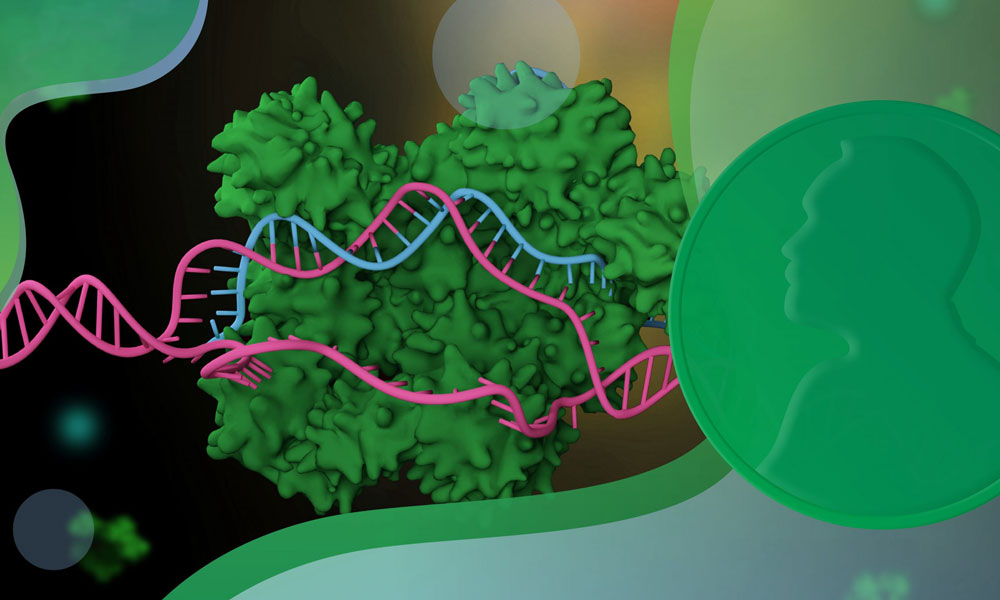Powerful genome editing tool recognised by Nobel Prize in Chemistry
Widespread CRISPR–Cas9 use at EMBL is key to expansive science and expanding methodology

The genome editing tool CRISPR–Cas9 – which plays a critical role in EMBL’s research – was today recognised by one of the most prestigious prizes in science: the Nobel Prize in Chemistry.
The Nobel Committee recognised Emmanuelle Charpentier, Director of the Max Planck Unit for the Science of Pathogens in Berlin and a former professor at the Laboratory for Molecular Infection Medicine Sweden – a member of the Nordic EMBL Partnership for Molecular Medicine – and Jennifer Doudna, a professor at the University of California, Berkeley, for their development of CRISPR–Cas9 for genome editing.
“When it became clear that we could tweak this mechanism into a powerful gene editing technology, I followed my initial interest in seeing the technology applied to the field of human medicine. It is quite rare in science to see the development of so many applications for one technology, and so quickly,” said Emmanuelle during an interview at EMBL in 2016. “Exactly how the different applications will develop in the future is still hard to define, but I am very pleased to see that many medical geneticists are embracing it.”
“The beauty of these discoveries is that they stemmed from purely fundamental, curiosity-driven research,” said EMBL Director General Edith Heard, commenting on today’s announcement. “Charpentier and Doudna and their colleagues were striving to understand the defence strategies bacteria use – CRISPR–Cas microbial adaptive immune systems – and came up with discoveries that have transformed the life sciences.”
“Emmanuelle and Jennifer are clearly curiosity-driven scientists who have changed the world. We are very proud that Emmanuelle carried out some of this discovery in the EMBL Partnership site at the Laboratory for Molecular Infection Medicine Sweden (MIMS),” said Ewan Birney, Deputy Director General of EMBL and Joint Director of EMBL’s European Bioinformatics Institute (EMBL-EBI).
Based on an ancient bacterial defence mechanism, CRISPR’s enormous potential for gene editing was only discovered during the past decade. CRISPR is built from an individually designed RNA strand and a DNA-cutting protein, such as Cas9. Three important qualities make this tool invaluable for the life sciences: it is cheap, easy to use, and very precise. With CRISPR, it’s possible to target any known DNA region and deactivate a gene or introduce a new one. From medical therapy to fundamental research, CRISPR has a wide range of applications and is used by research groups at EMBL to address important questions in biology. EMBL researchers have also worked to improve CRISPR technology.
EMBL scientists were part of an international collaboration to develop a new kind of CRISPR platform called MAGESTIC. The new platform allows CRISPR to operate less like a blunt cutting tool and more like a word processor by enabling an efficient ‘search and replace’ function for genetic material.
EMBL’s Steinmetz group found a way to improve CRISPR–Cas9 functional genomics screens, which allow scientists to study the functions of genomic elements in a systematic way, by modifying thousands of genes in a single experiment. The group designed a new approach for analysing the outcome of genome-wide CRISPR–Cas9 screens, called Targeted Perturb-seq (TAP-seq).
“CRISPR has revolutionised the way we can do our science – both in terms of opening up access to whole new scientific questions and also by completely changing the scale at which we can make discoveries,” said Jamie Hackett, a group leader at EMBL Rome. “The power of CRISPR is not just in its precision to introduce genomic changes but also in its relative ease of use – this democratises science to enable faster research discovery.”
That was clearly the case when EMBL researchers applied CRISPR technology to cancer research. They were able to disrupt every gene in more than 300 cancer models, revealing thousands of genes essential for cancer survival. This kind of research helps scientists to determine which cancer therapeutics are the best candidates to treat specific types of cancer, accelerating the search for cures.
CRISPR is prominent in many EMBL research groups. The Korbel group at EMBL Heidelberg uses CRISPR to discern the extent to which cancer cell mutations interact with one another. The Hackett group at EMBL Rome goes beyond genetic editing to use CRISPR for epigenetic editing as well. The Steinmetz group uses CRISPR to study how an organism’s phenotype – its observable characteristics – is affected by substituting just a single DNA base for another at a specific location in the genome.
“The discovery and widespread use of CRISPR–Cas9 technology – the now widely known ‘gene scissors’ – has opened up a number of incredible new possibilities in biology and medicine,” said EMBL group leader, Senior Scientist, and Head of Data Science Jan Korbel.
Lars Steinmetz, Senior Scientist and Director of the Stanford | EMBL Life Science Alliance, added, “It is an extremely versatile tool that can be used in a range of organisms from yeast to mammalian cells, and has revolutionised the way we approach genetics, precision health, and biotechnology. The award is a fantastic recognition of Jennifer and Emmanuelle’s groundbreaking development.”



